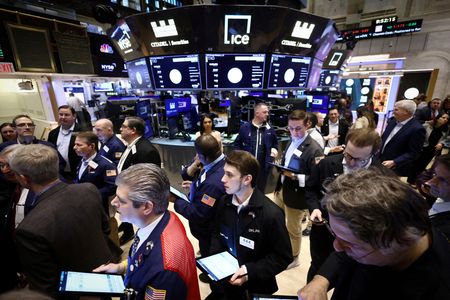By David Randall
NEW YORK (Reuters) – Cracks are widening in an early-year rally in stocks, as rising Treasury yields bolster the allure of bonds and skew equity valuations.
For weeks, stocks have largely withstood a rise in Treasury yields that has come amid signs that the Federal Reserve may have to raise rates higher than expected to cool the economy and tame inflation.
Market participants warn, however, that yields are reaching a danger zone where equities quickly lose their luster. Yields on six-month Treasuries, for example, are at their highest in nearly 16 years, offering investors 5.02% on an asset many consider far safer than stocks.
“All of a sudden inflation is a little bit stronger than we thought and the Fed looks like they will keep raising rates, and that’s absolutely a challenge for stocks when you can get short-term paper that yields 5%,” said Jonathan Golub, chief U.S. market strategist at Credit Suisse.
Stocks are still sitting on sizeable year-to-date gains, though some of their rally has melted away in recent days. The S&P 500 is down 4.4% from its recent highs, but remains up 4.1% year-to-date. The index fell more than 2% on Tuesday, its worst single-day drop of 2023.
The benchmark 10-year Treasury yield, which moves inversely to bond prices, is up around 60 basis points from its January lows.
Some strategists warn that a so-called no-landing scenario, where the Fed is not able to cool the economy anytime soon, could force policymakers to dole out more of the rate increases that shook markets last year, potentially pushing yields even higher.
Strategists at BlackRock, the world’s largest asset manager, said on Tuesday that policy tightening from the Fed would likely be “bad news for risk assets.”
The firm said it was increasing allocations to short-term Treasuries, keeping exposure to developed market stocks at an “underweight” and increasing exposure to emerging markets.
“Fixed income finally offers ‘income’ after yields surged globally,” the firm’s strategists wrote. “This has boosted the allure of bonds after investors were starved for yield for years.”
‘DEATH ZONE’
Markets on Tuesday afternoon were pricing in a 24% chance that the Fed raises rates by 50 basis points at its March 22 meeting, up from a 0% chance a month ago, according to CME’s FedWatch tool.
Analysts at Morgan Stanley, meanwhile, noted on Tuesday that the equity risk premium – or the potential reward that investors gain by holding stocks over bonds – has now fallen to levels last seen in 2007 due to higher yields and the likelihood of earnings disappointments ahead.
That is a “death zone” that makes the “risk-reward very poor” for stocks, strategist Michael Wilson wrote.
“We believe the risks are extreme now and nearly impossible to justify with any narrative one wants to conjure up,” Wilson said.
Golub, of Credit Suisse, is bullish on non-U.S. stocks, which he said are trading at more attractive valuations at a time when rising yields and inflation could pressure U.S. corporate costs.
The Stoxx 600 index of European companies, for example, trades at a forward price to earnings ratio of 12.8, well below the 18.2 seen in the S&P 500, while Japan’s Nikkei 225 trades at a forward P/E of 15.4.
“If you go outside of the U.S. you can get better underlying corporate profit growth for less money,” Golub said.
To be sure, bullish investors might have history on their side, thanks in part to January’s hefty 6.2% gain for the S&P 500. Years in which the S&P 500 has advanced in January have posted an additional gain in the subsequent February-December period 83% of the time, with an average 11-month rally of over 11%, according to CFRA Research.
Others see a stalemate ahead where markets make little headway. Elizabeth Burton, client investment strategist at Goldman Sachs, expects higher yields to weigh on technology stocks. At the same time, she believes many investors will be hesitant to sell equities after last year’s steep declines, when the S&P 500 lost 19.4%. The firm has a neutral outlook for the next 12 months.
“This is becoming more of a stockpicker’s environment where you can’t count on a rising tide lifting all boats,” she said.
(This story has been refiled to add the missing words “yields on” in paragraph 3)
(Reporting by David Randall in New York; Editing by Ira Iosebashvili and Matthew Lewis)

